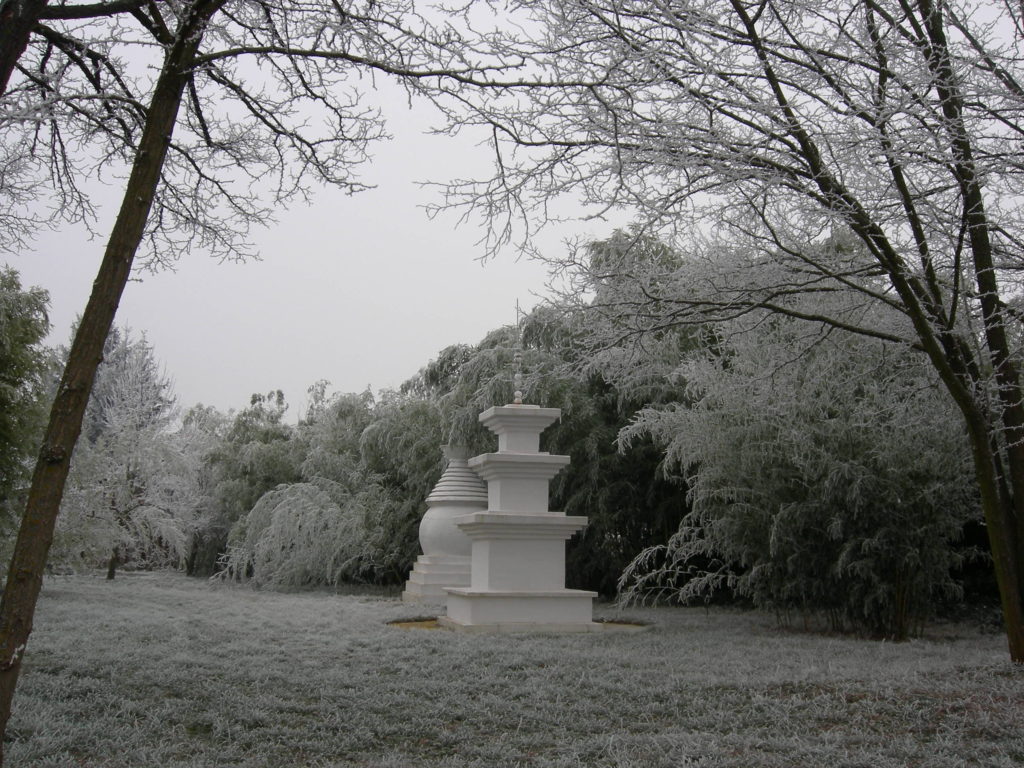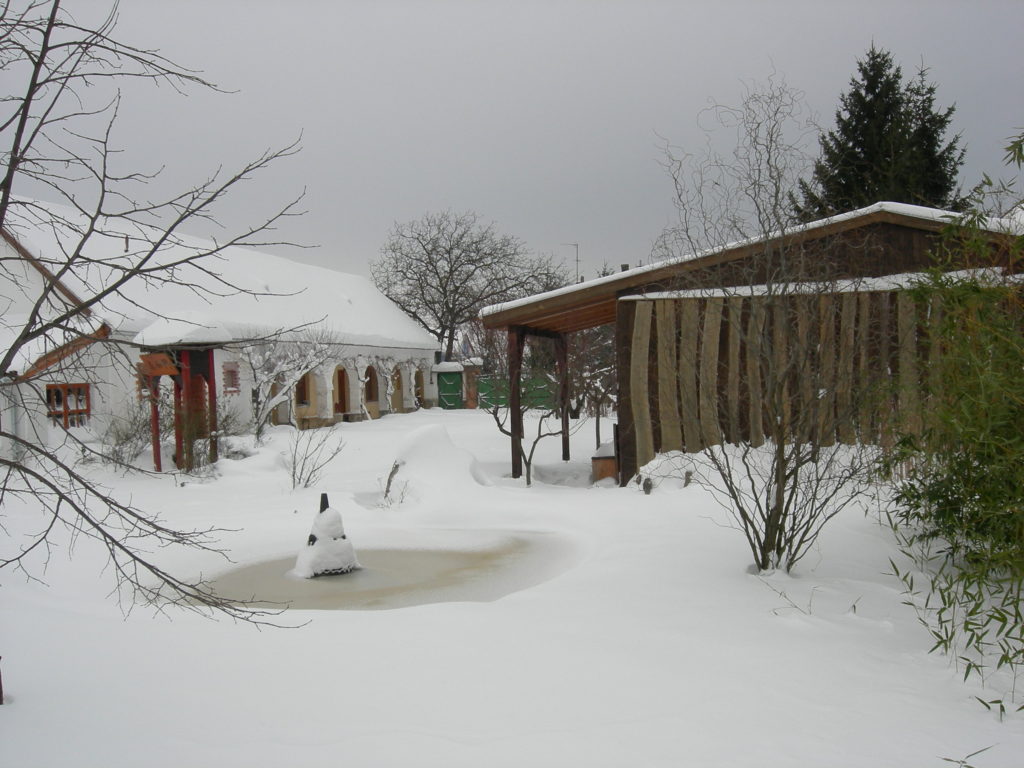
Werner Kodytek ist in der Welt schon viel herumgekommen. Nicht nur in der realen mit Konzerten in Übersee und Asien, sondern auch in der musikalischen. Der Experte für asiatische Saiteninstrumente ist ein Musiker, der stilistisch wie kaum ein anderer zwischen den Stühlen sitzt und diese Freiheit auch vortrefflich auszuleben weiß. Der gebürtige Wiener im Interview.
Dein aktuelles Konzertprogramm ist ein Soloprogramm, eine doch schwierige Form. Warum?
Ich bin Solist und unsicher ob ich überhaupt noch musikalisch sozialisierbar bin. Sicher bedingt durch meine zurückgezogene Lebensweise, fernab der Städte. Das prägt natürlich mein Musizieren. Doch ich mag es sehr ganz kompromisslos sein zu können. Das in sich Hineinhorchen wird dabei lauter und das Produzieren von Tönen kann einspitzig sein. Einspitzig im Sinne von: Nichts anderes als Wahrnehmung. Eremitenmusik könnte eine Bezeichnung dafür sein. Meine Musik kommt zwar nicht aus der Wüste, dafür aus der ungarischen Puszta.
Deine Musik ist sehr meditativ, welche Rolle spielen da die Zuhörer?
Eine solche Musik kann auch nicht in erster Linie publikumsorientiert sein. In dieser Haltung wurde ich sehr bestärkt durch ein Studium der japanischen spirituellen Musik in Kyoto. Die Aufführenden dieser Musiktraditionen, Shomyo und Gagaku, bezeichnen ihre Musik nicht einmal als solche, vielmehr ist es eine Praxis zur Kultivierung von Herz und Geist.
Bemerkenswert dabei ist, dass eine Musik die nicht hauptsächlich für ein Publikum gespielt wird, ähnlich wie das indonesische Gamelan, zu den ältesten noch lebenden Musiktraditionen zählt. Das liegt sicher zu einem Großteil an der konservierenden Mentalität der Japaner, doch auch daran dass sie sich nicht mit kurzlebigen menschlichen Aspekten befasst, wie Emotionen oder Moden. Eher mit Überpersönlichem, wie dem Raum oder der Stille.
Es gibt dazu eine Geschichte aus der Frühzeit dieser Musiktradition, einem zentralasiatischen Brauch. Einmal im Jahr, zu einer von Astrologen exakt festgelegten Zeit, versammelte sich der Weisenrat des Umlandes, um eine zentrale Quelle. Dabei lauschten sie der Melodie der Wassertropfen. Diese wurde darauf für ein Jahr zur Melodie der Region.
Der Klang steht im Zentrum deiner musikalischen Ausdrucksform, was ist für dich das Besondere daran?
In Ostasien entwickelte sich eine Maxime, die der Zen Meister Rinzai geprägt hat: In den Klang eingehen, aber nicht von ihm betört werden. In den Klang eingehen, aber nicht von ihm gefesselt werden. Ich denke mit `in den Klang eingehen` ist ein egofreier Zustand gemeint, worin es nur reine Wahrnehmung gibt. Die Betörung entsteht durch unsere Identifikation mit dem Wahrgenommenen, dann wenn Gefühl, Wille und Denken bewertend Stellung nehmen. Es ist also eine Schulung in der Freiheit des Lassens. Mit Buddhas Worten: Das Gehörte soll lediglich ein Gehörtes sein, das Empfundene lediglich ein Empfundenes – die Dinge in ihrem Entstehen betrachtend und die Dinge in ihrem Vergehen betrachtend.
Dies sind alles große Worte, aber um sie wirklich zu beherzigen sollte man sie sogleich wieder vergessen. Besser ist es die Ohren zu öffnen, hören und wieder hören, hören bis nichts mehr zu hören ist, und dann zurückkehren zum Zustand dessen der niemals hörte. Solche Art überlieferter Betrachtungen hat offensichtlich ihren Einfluss auf mein Musikschaffen. Ihre Ablehnung der Verführung durch Musik trifft genau ins Herz eines Eremitenlebens. Ein Eremit muß radikal ehrlich zu sich sein, ansonsten leidet er an seinen Täuschungen. Seine Musik soll ihn nicht woanders hinführen als er schon ist. Dafür tiefer hinein wo er schon ist.
Eremit und Karriere, wie passiert das zusammen?
Sich einen Namen machen wollen kann auch nicht in seiner Absicht sein. Für ein Eremitenleben ist es sicher besser, sich schon vor dem Rückzug klar darüber zu werden, dass anhaltendes Glück nicht durch die Suche nach Glück gefunden werden kann. Das Begehren und Anhaften an flüchtenden Glücksmomenten ist für ihn Kitsch. Die Musik des Eremiten hingegen reflektiert das ästhetische Prinzip dass Schönheit nicht einfach das Gegenteil von nicht schön sein kann. Wahre Schönheit existiert in jener Sphäre, die der Unterscheidung zwischen schön und weniger schön vorausgeht. Dort kann jeder Ton zu seinem Ursprung zurückkehren, auch wenn das Klangbild noch so dicht ist.
Meditative Musik wird oft als stark beruhigend fast einschläfernd empfunden, wie siehst du das?
Eigentlich sollte sie die Funktion haben aufzuwecken. Im Gegensatz zur populären Musik hat sie jedoch nicht die Verlockung als Beweggrund, sondern Vergegenwärtigung. Der Wunsch einen stillen Geist musikalisch zum Ausdruck zu bringen, bleibt so lange zwiespältig, so lange unter Stille nur die Verdrängung und Abwesenheit von Gedanken und Geräuschen verstanden wird. Denken und hören passiert natürlich und unentwegt, aber davon unabhängig, oder hinter dem Gedankenstrom liegt eine beständige Stille und mit der kann man in Berührung sein. Das erscheint mir sehr essenziell und obwohl es sich für manche befremdlich religiös anhört ist es eigentlich nur die Kultivierung des Loslassens, was ein darüber Hinausgehen ermöglicht.
So habe ich gehört:
Auf dem Berggipfel eine einsame Hütte.
Die eine Hälfte bewohnt ein alter Eremit,
die andere nimmt eine Wolke ein.
Letzte Nacht stürmte es und die Wolke wurde verweht.
Der Stille eines alten Mannes ist eine Wolke wohl doch nicht gewachsen.
Sind die Grundlagen geschaffen so folgt das übrige von selbst. Der Eremit handelt absichtslos und seine Musik klingt daher mühelos. Die Kunst der Kunstlosigkeit gelingt ihm durch Nichteinmischung. Auf der Stufe der Unbewegtheit schlägt er die Trommel wie ein Irrer. Der Eremit malt sich die Schriftzeichen von Geburt und Tod auf die Stirn und wäscht sie erst ab wenn er die ungeborene Wirklichkeit realisiert. Die Augen liegen waagrecht, die Nase senkrecht, so war es schon immer. Lassen wir uns von nichts täuschen.
Die Inspiration zu deinen Aufnahmen sind ja sehr alte Höhlenzeichnungen, wie bist du darauf gestoßen?
Mein Interesse an der Musik der Eremiten anderer Zeiten, führte mich an den Rand der Wüste Gobi. Auf der Seidenstrasse in China, hinter den Dünen der klingenden Sande, liegt die Oase Dunhuang. Während nahezu 1000 Jahren, zwischen dem 4. und 15 Jhdt. wurden die Innenwände von 492 Höhlen vollständig bemalt. Die spirituellen Motive zeigen besonders häufig fliegende, feinstoffliche Wesen mit Musikinstrumenten. Es lebten also vor 1500 Jahren Eremiten in Höhlen, wo die Abbildungen von fliegenden Musikern noch einen zusätzlichen Klangraum schufen. Wir wissen nichts über die Musik der Bewohner aber wir wissen welche Musik-Bilder sie beeinflussten.
Es gibt dort einen Mythos über die Wächter der Himmelsrichtungen. Der Wächter des östlichen Tores ist Dhritarashtra, der auch der Leiter und Konzertmeister der himmlischen Musiker ist. Er hat die Eigenheit, dass alle Klänge die er hört, zu ihrem Ursprung zurückschallen und dort Leiden verursachen. Aber da er doch kein Leiden verursachen will muss er verhindern sie zu hören. Darum spielt er selbst die Laute um sie zu übertönen und so wie er manchmal dargestellt wird, zieht er sich einen Helm aus Elefantenhaut tief über die beiden Ohren.
Das erste Stück meiner neuen DVD hat diesen Argentyp zum Inhalt. Sie ist eine Hommage an die fliegenden Musiker in den Höhlen der klingenden Sande, deren figurale Darstellung der Bewegung des vom Wind bewegten Sandes gleicht.
Du verwendest ja ein unterschiedliches Spektrum an Instrumenten. Was ist der Ausgangspunkt dafür?
Mein Instrumentarium besteht durchgehend aus den gleichen Instrumententypen wie sie an den Wänden dargestellt wurden. Verschiedene Wölbbrettzithern, Mundorgeln, Oboe, Gesang, etc. Organische Instrumente die auch im Einklang mit meinem natürlichen Lebensumfeldes stehen und die mir selbst beim spielen ein ganzheitliches erhellen meiner Zellen ermöglicht.
Akasagarbha, das zweite Stück ist eine Anrufung des unbegrenzten Raumes. Aufgeführt auf Instrumenten des japanischen Gagakuorchesters unter Mitwirkung eines Gebetsventilators, der die aufgemalten Samensilben in die offene Weite verquirrelt. Mein Gesang ist von der Shomyo- Liturgietradition inspiriert die zurück geht auf die Ausbildung der frühen indischen Brahmanen in der Wissenschaft vom Klang und die Verbindung von Klang mit Schriftzeichen. Dieses Spezialfach wanderte über Dunhuang nach China, Korea und Japan. Samensilben sind demnach Träger von Klang -Vibration mit der Wirkkraft von geistigen Inhalten.
Das Stück endet mit meinen Schlägen auf der größten Trommel der Welt, die in Korea steht und deren beide Seiten mit je 13 Kuhhäuten bespannt ist.
Im Vorspann dieses Stückes kann man lesen: Die einzige Schwierigkeit, einstmals wie heute, besteht darin Flaches und Fades hervorzubringen. Denn man weiß „dass das Flache sich bis in die Tiefe erstreckt“ und das Fade „die gesamte Fülle enthält“, Von Wu Kai einem chinesischen Literaturkritiker aus dem 12. Jhdt. und Worte die wie Wasser auf die Mühlen des Eremiten fließen.
Das dritte und letzte Stück ist eine Anrufung einer Personifikation des Mitgefühls. Avalokiteshvara zählt zu den häufigsten Darstellungen in den Höhlen von Dunhuang und mit ihm geht einher eine Klang Meditationspraxis. Durch das Anrufen dieser Personifikation will man seiner stellvertretenden Qualität Raum geben sich im Jetzt zu vergegenwärtigen. Oder auch, sich von der Qualität selbst angerufen wissen.
Aufgewertet wird meine Arbeit durch Beiträge von Min Young, einer koreanischen Sanduhrtrommlerin und dem Mundorgelspiel von.Achim Willfahrt.
Wie war deine musikalische Sozialisation, was hat dich zu deiner heutigen Musizierform gebracht?
Der Wunsch nach musikalischem Ausdruck, zusammen mit dem inspirierenden Hören ethnischer, spiritueller und neuer Musik führte zum autodidakten Erlernen vieler verschiedener Instrumente. Mir lag weniger daran ein Instrument so virtuos zu beherrschen um damit alles spielen zu können. Eher geht es mir darum mit vielen Instrumenten eines spielen zu können, nämlich die Anrufung der unbehinderten gegenseitigen Durchdringung. Die Gefahr dadurch im unprofessionellen zu rühren, erachte ich eher als eine Chance den Anfängergeist zu bewahren.
Nach den mehrjährigen Aufenthalten in asiatischen buddhistischen Kulturen und dem Studium in Kyoto habe ich viele Jahre in Wien eine „Arbeitsgruppe für neue buddhistische Musik“ geleitet. Dieses war und ist die eine Schiene meiner Aktivität, die andere ist die Produktion von neuer Musik ohne vordergründige Verbindung zum Spirituellen. Manchmal überlagern sich aber auch beide Schienen.
In meiner Laufbahn gab es die Teilnahme an verschiedenen kleinere Formationen, sie endete in der Zusammenarbeit mit dem „European Experimental Composer Orchester“ welches 1995 in Kopenhagen gegründet wurde. Seit her lebe ich zurückgezogen auf dem Lande und dem entsprechend ist meine Musik eine vorwiegend solistische.
Wie weit sind deine Stücke an eine feste Komposition gebunden?
Grundsätzlich habe ich die Neigung mit unorthodoxen Spieltechniken frische, unverbrauchte Klangräume erzeugen zu wollen. Dabei ist die Improvisation für mich das Einzig in Frage kommende. Das Spüren der direkten Umsetzung meiner Energie, die Schwächung der Beobachterfunktion zugunsten des freien Fluges der Inspiration, die Wahrnehmung des eigenen Geistes in seiner Fülle an Klang-Bilder-Schichten, dafür lohnt es sich. Natürlich gibt es angewandte Erinnerung aber ich vermeide es so gut es geht mich an Vorgaben zu halten. Abgesehen von Reihenfolgen oder Struktur eines Stückes, will ich immer neues von mir hören.
Wie wird dein Live Setting aussehen?
An die Wand hinter mir wird meine filmische Bearbeitung der Höhlenmalerei von den fliegenden Musikern projiziert. Davor spiele ich auf dem Kayagum – koreanische Wölbbrettzither, dem Ajäng – eine andere koreanische Zither, den beiden japanischen Gagakuinstrumenten Ryuteki – Flöte und Hishiriki – Oboe. Die Khene – laotische Mundorgel, die Sho – japanische Mundorgel sowie das Spiel der koreanischen Dschangospielerin sind im Video vorgefertigte Klangräume zu denen ich kommuniziere.
Welche Aufführungsorte sind für dich die beste Umgebung um deine Musik zu präsentieren?
Überall dort wo Raum und Publikum Neuem gegenüber offen ist. Ein für mein Gefühl ästhetischer Raum hat sicher eine förderliche Auswirkung auf meinen Inspirationsfluss. Ein klarer Raum ist mir jedenfalls lieber als ein Raum der Achtlosigkeit.
Da du eine DVD veröffentlichst scheint das Visuelle ein wesentlicher Bestandteil deiner Musik zu sein. Ist das richtig? Oder anders gefragt, braucht deine Musik vorgegebene Bilder?
In der schlichten Schönheit meiner altertümlichen Instrumente liegt so etwas wie der Auftrag gesehen zu werden. Sie sind es die die Vorgaben legen, Hindernisse und Begrenzungen, aber auch eine Vielfalt von Möglichkeiten. Ihnen verdanke ich ein Leben im Experiment. Meine Musik braucht nicht vorgegebene Bilder, aber in der Verbindung mit den Höhlenmalereien von fliegenden Musikern eröffnet sie die Möglichkeit Klänge sehen und Bilder hören zu können. Das wollte ich nicht ungenützt lassen.












